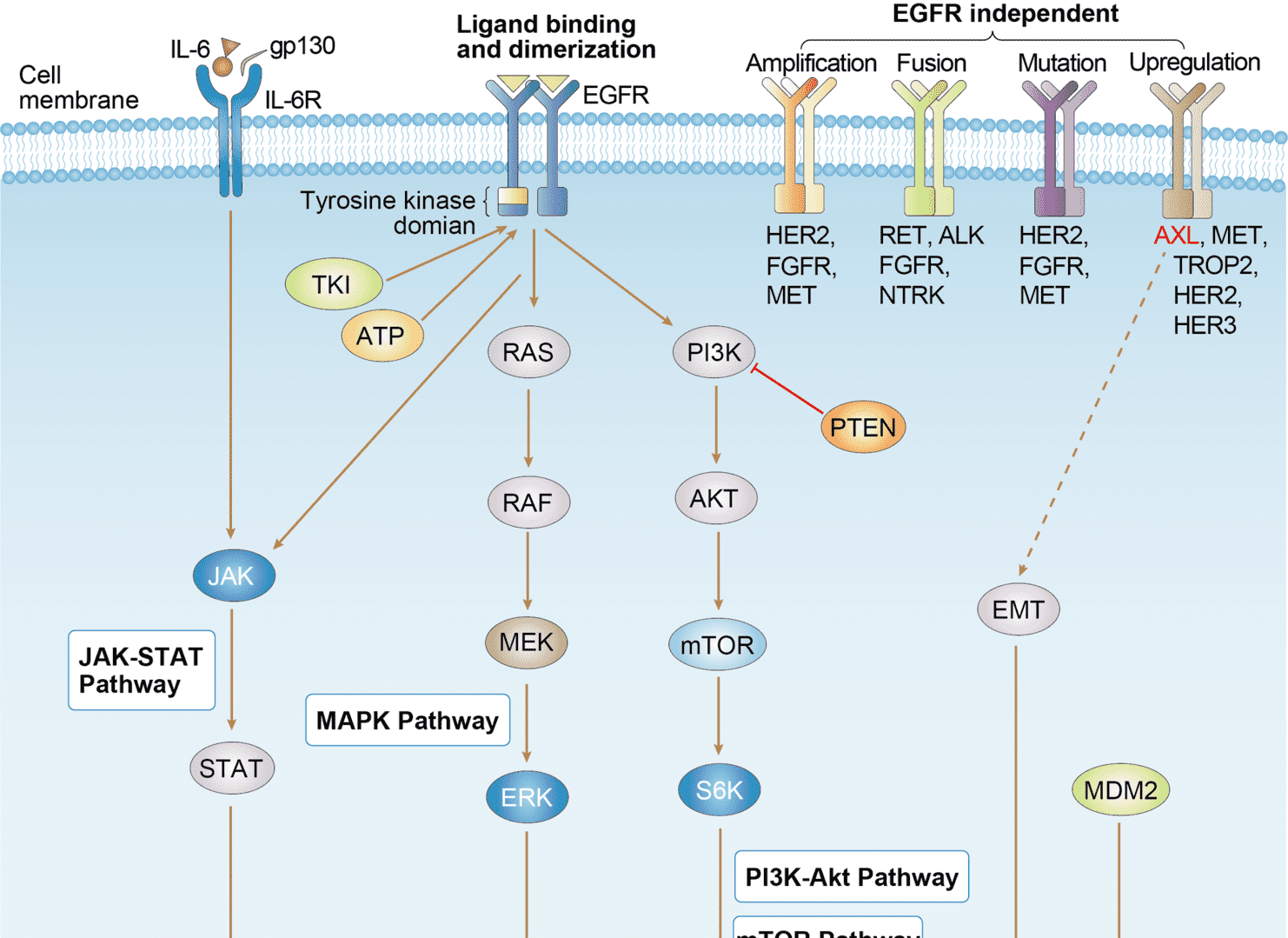 Loading...
Loading...

MET

Cancer-related genes, Disease related genes, Enzymes, FDA approved drug targets, Human disease related genes, Metabolic proteins, Plasma proteins, RAS pathway related proteins
Intracellular, Membrane, Secreted (different isoforms)
Cell type enhanced (Glandular and luminal cells, Prostatic glandular cells, Urothelial cells, Alveolar cells type 2, Club cells, Pancreatic endocrine cells)
Not detected in immune cells
Cell line enhanced (A-431, CAPAN-2)
Heterodimer made of an alpha chain (50 kDa) and a beta chain (145 kDa) which are disulfide linked. Binds PLXNB1. Interacts when phosphorylated with downstream effectors including STAT3, PIK3R1, SRC, PCLG1, GRB2 and GAB1. Interacts with SPSB1, SPSB2 and SPSB4 (By similarity). Interacts with INPP5D/SHIP1. When phosphorylated at Tyr-1356, interacts with INPPL1/SHIP2. Interacts with RANBP9 and RANBP10, as well as SPSB1, SPSB2, SPSB3 and SPSB4. SPSB1 binding occurs in the presence and in the absence of HGF, however HGF treatment has a positive effect on this interaction. Interacts with MUC20; prevents interaction with GRB2 and suppresses hepatocyte growth factor-induced cell proliferation. Interacts with GRB10. Interacts with PTPN1 and PTPN2. Interacts with LECT2; this interaction may have an antagonistic effect on receptor activation (PubMed:27334921). Interacts with HSP90AA1 and HSP90AB1; the interaction suppresses MET kinase activity (PubMed:26517842). (Microbial infection) Interacts via extracytoplasmic residues 25-656 with L.monocytogenes InlB; MET can bind HGF, its endogenous ligand, and InlB simultaneously (PubMed:11081636, PubMed:17662939). InlB probably dimerizes upon binding to MET, which encourages subsequent dimerization of MET (Probable).
Kinase, Receptor, Transferase, Tyrosine-protein kinase
-
- Derivation: Humanized
- Species Reactivity: Human
- Type: Human scFv
- Application: ELISA, Neut
-
- Derivation: Humanized
- Species Reactivity: Human
- Type: Human Fab
- Application: ELISA, Neut
-
- Derivation: Mouse
- Species Reactivity: Human
- Type: ADCC enhanced antibody
- Application: ELISA, Neut
-
- Derivation: Human
- Species Reactivity: Human
- Type: Human Fab
- Application: WB, Block, FuncS
-
- Derivation: Human
- Species Reactivity: Human
- Type: Human scFv
- Application: WB, Block, FuncS
-
- Derivation: Human
- Species Reactivity: Human
- Type: Human IgG
- Application: WB, Block, FuncS
- Recombinant Mouse Anti-Human c-Met antibody (MOB-0349MC)
-
- Species Reactivity: Human
- Application: WB
- Mouse Anti-MET Recombinant Antibody; scFv Fragment (TAB-534LC-S(P)) (TAB-534LC-S(P))
-
- Species Reactivity: Human
- Type: Mouse scFv
- Application: FC, ELISA, TR-FRET
- Mouse Anti-MET Recombinant Antibody (TAB-535LC) (TAB-535LC)
-
- Species Reactivity: Human
- Type: Mouse IgG
- Application: FC, FuncS, Inhib
- Anti-Human MET Recombinant Antibody (MvDN30) (TAB-002MZ)
-
- Type: Chimeric antibody (mouse/human)
- Application: IHC, PET imaging
- Anti-Human MET Recombinant Antibody Fab Fragment (TAB-0530CL-F(E))
-
- Application: ELISA, FC, IF, FuncS
- Mouse Anti-MET Recombinant Antibody (TAB-534LC) (TAB-534LC)
-
- Species Reactivity: Human
- Type: Mouse IgG
- Application: FC, FuncS, Inhib
- Anti-Human MET Recombinant Antibody scFv Fragment (TAB-0530CL-S(P))
-
- Application: ELISA, FC, IF, FuncS
- Human Anti-MET Recombinant Antibody; Fab Fragment (TAB-0332CL-F(E)) (TAB-0332CL-F(E))
-
- Species Reactivity: Human
- Type: Humanized Fab
- Application: ELISA
- Human Anti-MET Recombinant Antibody; scFv Fragment (TAB-0332CL-S(P)) (TAB-0332CL-S(P))
-
- Species Reactivity: Human
- Type: Humanized scFv
- Application: ELISA
- Human Anti-MET Recombinant Antibody (TAB-0332CL) (TAB-0332CL)
-
- Species Reactivity: Human
- Type: Humanized Antibody
- Application: ELISA
- Anti-Human MET Recombinant Antibody (TAB-0530CL)
-
- Application: ELISA, FC, IF, FuncS
- Anti-Human MET Recombinant Antibody (ABT-700) (TAB-521CL)
-
- Derivation: Humanized
- Species Reactivity: Human
- Type: Antibody
- Application: WB, FuncS
- Anti-Human Met(Onartuzumab) (TAB-190-F(E))
-
- Derivation: Humanized (from mouse)
- Species Reactivity: Human
- Type: Fab / Fc - G1 - kappa
- Application: IP, IF, FuncS, FC, Neut, ELISA, ICC
-
- Derivation: Humanized
- Species Reactivity: Human
- Type: ADCC enhanced antibody
Our customer service representatives are available 24 hours a day, from Monday to Sunday. Contact Us
Can't find the products you're looking for? Try to filter in the left sidebar.Filter By Tag
For Research Use Only. Not For Clinical Use.

 EGFR Tyrosine Kinase Inhibitor Resistance
EGFR Tyrosine Kinase Inhibitor Resistance